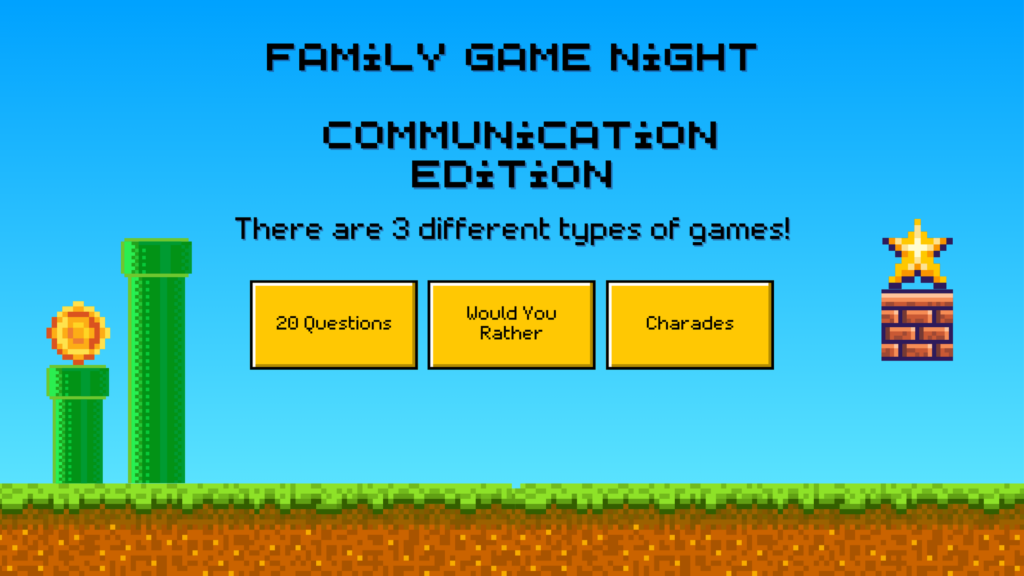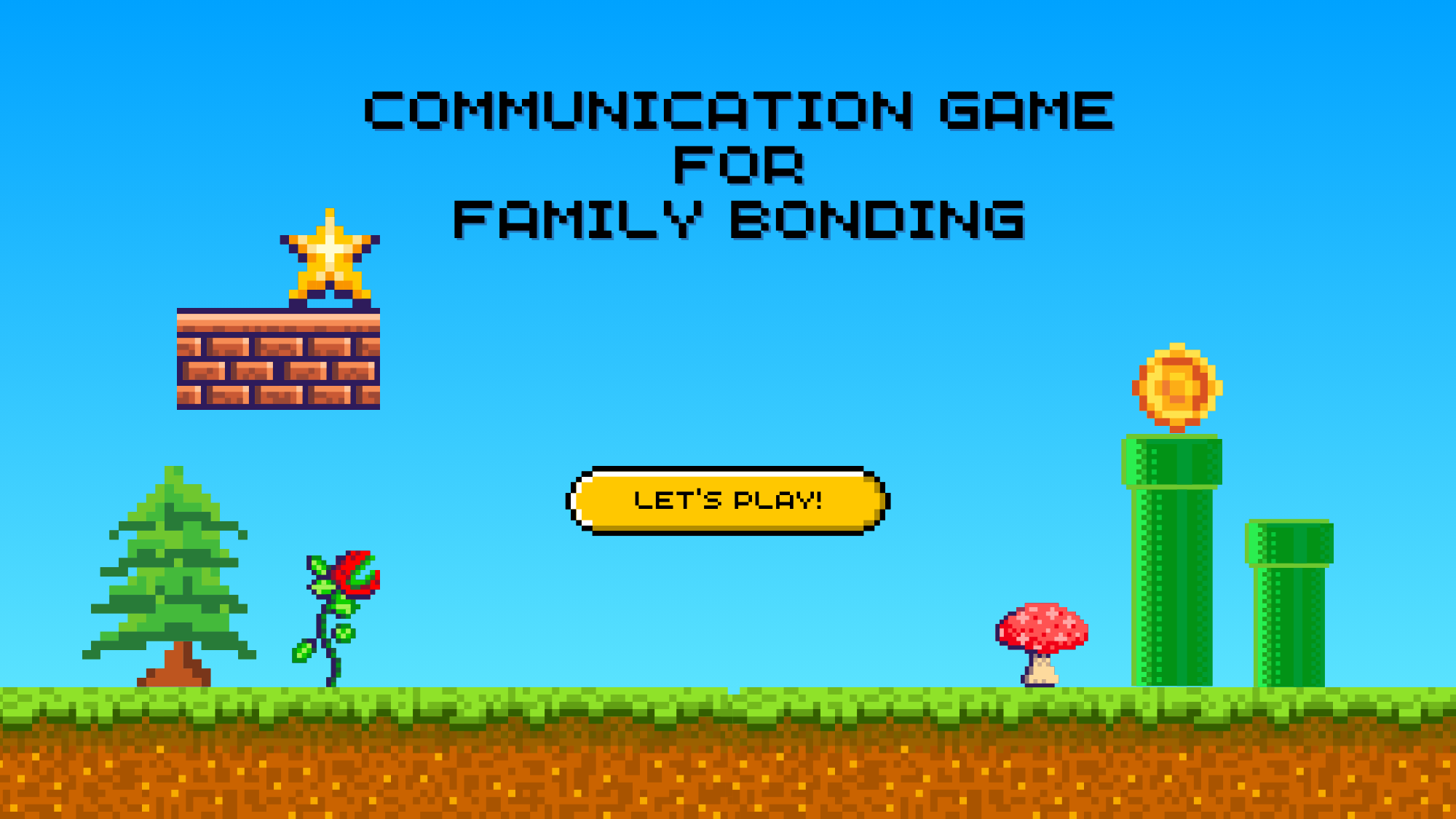Table of Contents
Introduction For Communication Games
In this ultimate guide, we’ll delve into the transformative power of communication games for family bonding. From sparking laughter during family game nights to facilitating heartfelt conversations over dinner, these games offer a myriad of opportunities to strengthen the ties that bind us.
Throughout this guide, we’ll explore a diverse range of communication games tailored to suit every family dynamic and age group. Whether you’re looking to break the ice, build trust, or simply share a laugh, there’s a game here for you. So, gather your loved ones, set aside some time, and get ready to embark on a journey of connection and discovery.
Family Game Night – Communication Edition

Family game nights are cherished traditions that bring laughter, camaraderie, and unforgettable memories. But why not take it a step further and infuse your game nights with the magic of communication? Welcome to the Communication Edition of Family Game Night – an evening dedicated to fostering deeper connections and strengthening bonds through interactive and engaging communication games.
Imagine the joy of gathering around the table with your loved ones, ready to embark on a journey of laughter and discovery. Here, communication games take center stage, offering a delightful blend of fun and meaningful interaction.
- “20 Questions” – A timeless classic, “20 Questions” challenges players to guess the identity of a mystery object or person by asking yes-or-no questions. It’s a fantastic icebreaker that encourages creativity, critical thinking, and teamwork.
- “Would You Rather” – Prepare for laughter and lively debate with “Would You Rather.” Players take turns posing hypothetical scenarios, prompting hilarious discussions about preferences, values, and priorities. It’s a fantastic way to gain insight into each other’s personalities while sharing plenty of laughs along the way.
- “Charades” – No family game night is complete without a rousing game of Charades. Get ready to channel your inner actor as you pantomime words, phrases, and movie titles for your team to guess. It’s a fantastic exercise in non-verbal communication and teamwork that’s sure to elicit plenty of laughter and excitement.
Tips for Hosting a Successful Family Game Night –
- Set the Stage – Create a cozy and inviting atmosphere with soft lighting, comfortable seating, and plenty of snacks and beverages to keep everyone energized.
- Choose a Variety of Games – Cater to different preferences and ages by selecting a mix of communication games that appeal to everyone in the family.
- Embrace Friendly Competition – While the focus is on communication and connection, a little healthy competition can add to the fun. Keep score, award prizes, and celebrate each other’s victories with enthusiasm.
- Encourage Participation – Ensure that everyone has the opportunity to participate and contribute to the games. Encourage shy or reserved family members to join in by offering support and encouragement.
With these tips in mind, you’re well on your way to hosting an unforgettable Family Game Night – Communication Edition. So, gather your loved ones, prepare to laugh, and get ready to strengthen your family bonds like never before.
Role-Playing for Effective Communication
Role-playing isn’t just for the stage – it’s a powerful tool for honing effective communication skills within your family circle. By stepping into different roles and exploring various scenarios, you can gain valuable insights into each other’s perspectives, enhance empathy, and strengthen your bonds in the process.
- Practicing Empathy and Understanding – Role-playing allows family members to put themselves in each other’s shoes, gaining a deeper understanding of their thoughts, feelings, and experiences. Whether it’s acting out a conflict resolution scenario or reenacting a memorable family moment, role-playing fosters empathy and encourages compassionate communication.
- Tailored Scenarios for Every Family – From young children to grandparents, role-playing can be tailored to suit every member of the family. For younger children, simple scenarios like pretending to be animals or favorite storybook characters can spark creativity and imagination. Older children and teenagers may benefit from role-playing social situations, such as peer pressure or bullying, to develop assertiveness and confidence. Adults can explore more complex scenarios, such as navigating work-related conflicts or discussing financial decisions, to enhance communication and problem-solving skills.
- Conflict Resolution and Bonding – One of the most significant benefits of role-playing is its ability to facilitate conflict resolution and strengthen familial bonds. By rehearsing difficult conversations or revisiting past conflicts in a safe and controlled environment, family members can practice active listening, express their emotions constructively, and work towards mutually beneficial resolutions. Role-playing fosters open communication builds trust, and cultivates a supportive family dynamic based on empathy and understanding.
Example Scenarios –
Reenacting a recent family disagreement to explore alternative resolutions and understand each other’s perspectives.
Pretending to be characters from a favorite movie or TV show and discussing how they would handle a challenging situation. Acting out everyday scenarios, such as ordering food at a restaurant or asking for directions, to practice communication skills in real-life contexts.
Incorporating role-playing into your family routine can be a fun and rewarding way to strengthen your communication skills and deepen your connections with one another. So, don’t be afraid to embrace your inner actor and explore the transformative power of role-playing in your family’s journey toward effective communication and lasting bonds.
Conversation Starters for Family Dinners
When it comes to strengthening family bonds, the dinner table is often the heart of the home – a place where you come together to share not just food, but also stories, laughter, and meaningful conversations. Introducing conversation starters into your family dinners can transform mealtime into an opportunity for connection, reflection, and growth.
Facilitating Meaningful Discussions –
Conversation starters serve as catalysts for sparking engaging and thought-provoking discussions among family members. Whether you’re discussing your day, sharing memories, or exploring new ideas, conversation starters provide a framework for connecting on a deeper level and strengthening your family bonds.
Engaging Prompts for All Ages –
From young children to grandparents, there are conversation starters tailored to suit every member of your family. For younger children, prompts may focus on imagination and creativity, such as “If you could have any superpower, what would it be?” or “What’s your favorite thing about school?” Teenagers may appreciate prompts that encourage self-reflection and goal-setting, such as “What’s one thing you hope to accomplish this week?” or “What’s a challenge you’ve overcome recently?” Adults can explore topics ranging from personal growth and relationships to current events and world issues, fostering meaningful discussions and strengthening family connections.
Incorporating Conversation Starters into Daily Routines –
Make conversation starters a part of your family’s daily routine by incorporating them into mealtime traditions or evening rituals. Whether it’s sharing a “question of the day” during breakfast, discussing highs and lows at dinner, or reflecting on gratitude before bedtime, integrating conversation starters into your family’s routine creates opportunities for bonding and communication throughout the day.
Sample Conversation Starter Prompts –
- If you could travel anywhere in the world, where would you go and why?
- What’s one thing that made you smile today?
- If you could have dinner with any historical figure, who would it be and what would you talk about?
- What’s a goal you’ve achieved recently, and how did it make you feel?
- What’s something new you’ve learned recently that you find fascinating?
By incorporating conversation starters into your family dinners, you can turn mealtime into a cherished opportunity for connection, reflection, and growth. So, gather around the table, pick a prompt, and let the conversation flow – because the memories you create together will nourish your family bonds for years to come.
Tech-Free Communication Challenges
In today’s digital age, technology plays a significant role in our lives, providing countless opportunities for connection and entertainment. However, amidst the convenience and connectivity, it’s essential to recognize the impact technology can have on family communication. Constant access to screens and devices can sometimes detract from face-to-face interactions and quality time spent together. That’s where tech-free communication challenges come in – offering a refreshing break from screens and an opportunity to reconnect with your loved ones in meaningful ways.
Understanding the Impact of Technology –
While technology has undoubtedly revolutionized communication, it’s essential to acknowledge its potential drawbacks, especially within the family dynamic. Excessive screen time can lead to decreased face-to-face interactions, reduced attention spans, and even feelings of disconnection among family members. By recognizing the impact of technology on family communication, you can take proactive steps to cultivate healthier habits and strengthen your family bonds.
Introducing Tech-Free Communication Challenges –
Tech-free communication challenges provide a structured framework for unplugging devices and prioritizing face-to-face interaction. Whether it’s a designated device-free hour each evening or a screen-free weekend once a month, these challenges encourage families to disconnect from technology and reconnect with each other. By setting boundaries around screen time, you create opportunities for meaningful conversations, shared experiences, and quality time spent together.
Alternative Activities for Connection –
When unplugging from technology, it’s essential to have alternative activities lined up to fill the void. Instead of staring at screens, consider engaging in activities that promote face-to-face interaction and foster family bonding. Whether it’s cooking a meal together, playing board games, going for a nature walk, or simply enjoying each other’s company, there are countless ways to connect without technology. By exploring new activities and interests as a family, you create lasting memories and strengthen your relationships in the process.
Sample Tech-Free Communication Challenges –
- Designate one evening per week as a “device-free dinner,” where phones, tablets, and computers are off-limits at the table.
- Implement a “screen-free Sunday” policy, where the entire family unplugs from screens and engages in offline activities together.
- Challenge each family member to spend at least one hour per day engaged in a tech-free activity of their choice, whether it’s reading, crafting, or playing a musical instrument.
By embracing tech-free communication challenges, you can reclaim precious moments of connection and create a more balanced approach to technology within your family. So, unplug, unwind, and rediscover the joy of face-to-face interaction – because the bonds you strengthen offline will be the ones that last a lifetime.
Building Trust through Communication Exercises
In any family, trust forms the foundation of strong relationships. When trust is present, family members feel safe, supported, and valued, creating an environment where communication can thrive. To cultivate trust within your family, consider incorporating communication exercises designed to foster openness, empathy, and understanding. These activities not only strengthen your bonds but also lay the groundwork for deeper connections and more meaningful interactions.
Exploring Communication Exercises –
Communication exercises provide structured opportunities for family members to engage with one another in meaningful ways. From active listening exercises to vulnerability-sharing activities, these exercises encourage empathy, validation, and mutual respect. By participating in these exercises regularly, you create a culture of openness and trust within your family, where everyone feels heard and understood.
Trust-Building Activities –
Active Listening – Practice active listening by allowing each family member to express themselves while others listen without interruption or judgment. Encourage reflective responses to demonstrate understanding and validate each other’s perspectives.
Vulnerability Sharing – Create a safe space for family members to share their thoughts, feelings, and experiences openly. Encourage vulnerability by leading by example and sharing your own emotions and challenges. This fosters trust and encourages authenticity within the family.
Empathy Exercises – Engage in empathy-building activities that help family members understand each other’s perspectives and experiences. Encourage reflection on how others might feel in different situations, fostering empathy and compassion.
Long-Term Benefits –
The benefits of trust-enhancing communication practices extend far beyond the immediate moment. By building trust within your family, you create a supportive environment where everyone feels valued and respected. This leads to increased cooperation, better conflict resolution, and enhanced emotional well-being for all family members. Over time, trust becomes the bedrock of your family relationships, strengthening your bonds and providing a solid foundation for growth and resilience.
As you engage in communication exercises aimed at building trust, remember that trust is a journey, not a destination. It requires ongoing effort, patience, and commitment from all family members. By prioritizing open communication, empathy, and vulnerability, you can cultivate a culture of trust that enriches your family life and strengthens your connections for years to come.
Creative Writing as Family Expression
Engaging in creative writing activities as a family provides a unique opportunity to express yourselves, unleash your imagination, and strengthen your bonds through storytelling and collaboration. Whether you’re crafting a fantastical tale together or composing heartfelt poetry, creative writing allows each family member to contribute their ideas, perspectives, and creativity to a shared endeavor.
Introduction to Creative Writing –
Creative writing encompasses a wide range of activities, from storytelling and poetry to journaling and fiction writing. It encourages self-expression, creativity, and imagination, making it an ideal medium for family bonding. By engaging in creative writing together, you create a space where everyone’s voice is valued, and each contribution adds to the richness of the shared experience.
Collaborative Writing Activities –
- Storytelling Relay – Start a storytelling relay where each family member contributes a sentence or paragraph to a story, passing it on to the next person to continue. Watch as the story evolves in unexpected and exciting ways, showcasing the collective creativity of your family.
- Family Poetry Sessions – Host family poetry sessions where everyone takes turns writing verses or stanzas of poetry on a chosen theme or topic. Encourage experimentation with different poetic forms and styles, celebrating the diversity of voices within your family.
- Creative Writing Projects – Embark on creative writing projects as a family, such as writing a short play, creating a family newsletter, or composing a collaborative novel. These projects foster teamwork, creativity, and a sense of accomplishment as you work together to bring your ideas to life.
Showcase of Creative Writing Projects –
- Family Storybook – Create a family storybook filled with stories, poems, and illustrations contributed by each family member. This cherished keepsake captures your family’s creativity and imagination, preserving it for generations to come.
- Collaborative Novel – Write a collaborative novel as a family, with each family member contributing a chapter or section to the story. Witness the story unfold as you blend your unique voices and ideas into a cohesive narrative.
- Poetry Anthology – Compile a poetry anthology featuring poems written by each family member. From heartfelt reflections to whimsical verses, the anthology reflects the diverse perspectives and experiences of your family, celebrating the power of words to connect and inspire.
By embracing creative writing as a form of family expression, you create opportunities for meaningful connection, self-discovery, and shared creativity. Whether you’re penning fantastical adventures or heartfelt reflections, the act of writing together strengthens your bonds and creates lasting memories that you’ll treasure for years to come.
Mindfulness and Family Connection
Incorporating mindfulness practices into your family’s routine can cultivate a sense of presence, connection, and emotional well-being. By engaging in mindfulness exercises together, you create opportunities to slow down, tune into the present moment, and strengthen your bonds as a family.
Explanation of Mindfulness Techniques –
Mindfulness involves paying attention to the present moment with openness, curiosity, and acceptance. It encourages us to become aware of our thoughts, feelings, and sensations without judgment, allowing us to cultivate greater clarity, compassion, and connection in our relationships.
Introduction to Mindfulness Exercises –
Mindful Breathing – Practice mindful breathing exercises as a family, focusing on the sensations of your breath as it enters and leaves your body. Encourage each family member to take slow, deep breaths, grounding themselves in the present moment and fostering a sense of calm and relaxation.
Gratitude Practice – Foster gratitude within your family by incorporating a gratitude practice into your daily routine. Take turns expressing gratitude for the simple joys and blessings in your lives, whether it’s a beautiful sunset, a warm hug, or a shared meal. Cultivating gratitude enhances appreciation and deepens your connection as a family.
Tips for Incorporating Mindfulness –
Set Aside Dedicated Time – Schedule regular family mindfulness sessions where you engage in mindfulness exercises together. Whether it’s a morning meditation session or an evening gratitude practice, designate time to connect mindfully as a family.
Create Mindful Rituals – Infuse mindfulness into daily rituals and activities, such as mindful mealtimes, mindful walks, or bedtime gratitude reflections. These rituals serve as anchors for presence and connection, fostering a sense of harmony and peace within your family.
Lead by Example – Model mindfulness for your children by practicing it yourself. Share your own experiences with mindfulness and its benefits, encouraging your family members to explore and embrace mindfulness in their own lives.
By incorporating mindfulness into your family’s routine, you create a foundation of presence, connection, and emotional well-being. Mindfulness practices offer valuable tools for navigating life’s challenges with grace and resilience, fostering deeper bonds, and enhancing the quality of your family relationships.
Using Art for Family Storytelling
Engaging in art-based activities provides a creative outlet for storytelling and self-expression within your family. By incorporating various art mediums into your storytelling endeavors, you can unlock imagination, foster collaboration, and deepen your family bonds through shared creativity.
Exploration of Art-Based Activities –
Art-based activities offer a unique avenue for family storytelling, allowing each member to express themselves visually and contribute to the narrative in their way. From drawing and painting to collage and sculpture, there are countless mediums to explore, each offering its opportunities for creative expression and connection.
Description of Art Mediums –
- Drawing and Painting – Encourage family members to illustrate their stories through drawing and painting. Whether it’s creating colorful characters, vibrant landscapes, or imaginative scenes, drawing and painting provide a canvas for storytelling and artistic expression.
- Collage and Mixed Media – Experiment with collage and mixed media techniques to tell stories through images and textures. Combine photographs, magazine clippings, found objects, and various materials to create layered and dynamic storytelling compositions.
Digital Art – Embrace digital art tools and software to explore storytelling in the digital realm. Use digital drawing apps, graphic design software, or animation programs to bring your family’s stories to life in a digital format.
Examples of Family Storytelling Projects –
- Family Storybook – Collaborate on creating a family storybook, where each family member contributes their own illustrated stories or chapters. Compile the stories into a cohesive narrative, accompanied by illustrations created by the entire family.
- Visual Journals – Start visual journals as a family, where each member documents their thoughts, experiences, and stories through art and writing. Share your journal entries, providing insight into your unique perspectives and creative expressions.
- Storytelling Workshops – Organize storytelling workshops where family members take turns leading storytelling sessions using various art mediums. Explore different themes, characters, and settings, allowing each storyteller to contribute to the collective narrative.
By using art as a vehicle for family storytelling, you create opportunities for imagination, creativity, and connection to flourish within your family. Through collaborative art projects and shared storytelling experiences, you cultivate a rich tapestry of memories, narratives, and bonds that strengthen your family’s connection for years to come.
Family Journaling – A Shared Diary
Embarking on a journey of family journaling offers a collaborative and enriching way to document cherished memories, experiences, and reflections together. By creating a shared diary, you not only capture the essence of your family’s unique story but also strengthen your bonds through shared introspection and connection.
Introduction to Family Journaling –
Family journaling serves as a collective repository of your family’s adventures, milestones, and everyday moments. It provides a space for each member to contribute their thoughts, feelings, and observations, fostering a sense of belonging and unity as you document your shared experiences.
Suggestions for Journaling Prompts and Formats –
- Gratitude Journals – Start each day or week by reflecting on moments of gratitude as a family. Write down things you’re thankful for, moments that brought you joy, or acts of kindness you’ve experienced or witnessed.
- Adventure Logs – Document your family’s adventures, outings, and travels in a shared adventure log. Include details about your experiences, places you’ve visited, and memorable encounters, accompanied by photos, sketches, or mementos.
- Reflection Prompts – Explore meaningful topics and themes through reflection prompts. Discuss family values, aspirations, challenges, and growth opportunities, encouraging open and honest dialogue within your family.
Ideas for Preserving and Sharing Family Journals –
- Digital Journals – Create a digital family journal using online platforms or dedicated journaling apps. Digital journals offer convenience, accessibility, and the ability to easily share and collaborate with family members, regardless of location.
- Physical Journals – Opt for traditional pen-and-paper journals for a tactile and personal touch. Choose beautiful notebooks or scrapbooks to document your family’s journey, adding handwritten notes, drawings, and keepsakes.
- Family Archives – Preserve your family journals for future generations by creating a family archive or memory box. Store physical journals in a safe and accessible location, accompanied by other family memorabilia and heirlooms.
By embracing family journaling as a shared diary, you create a legacy of memories, reflections, and connections that will be cherished for generations to come. Each entry serves as a testament to your family’s journey, values, and love that binds you together, strengthening your familial bonds and enriching your collective story.
Expressing Gratitude as a Family
Embracing gratitude as a family not only cultivates a deeper sense of appreciation for each other but also nurtures positivity and resilience within your family dynamic. Through intentional gratitude practices, you can foster a culture of appreciation, support, and connection that strengthens your bonds and enriches your shared experiences.
Discussion on the Importance of Gratitude –
Recognizing and expressing gratitude within the family context is crucial for nurturing healthy relationships and promoting emotional well-being. Gratitude serves as a powerful antidote to negativity, fostering resilience, and enhancing overall satisfaction with life. By acknowledging the blessings, big and small, you cultivate a mindset of abundance and joy, fostering a deeper sense of connection and fulfillment within your family.
Introduction to Gratitude Practices for Families –
- Daily Gratitude Circles – Gather as a family each day to share moments of gratitude and appreciation. Take turns expressing what you’re thankful for, whether it’s a supportive family member, a joyful moment, or a simple act of kindness.
- Thank-You Notes – Encourage family members to express gratitude through handwritten thank-you notes or messages. Whether it’s expressing appreciation for a thoughtful gesture or acknowledging someone’s efforts, these heartfelt messages foster a culture of appreciation and reciprocity.
Examples of Gratitude Rituals –
- Gratitude Jar – Create a family gratitude jar where each member can write down things they’re grateful for and place them in the jar throughout the week. Set aside time to read aloud the notes and reflect on the abundance of blessings within your family.
- Gratitude Walks – Take family walks together in nature, expressing gratitude for the beauty of the surroundings and the opportunity to spend quality time together. Encourage mindfulness and presence as you connect and the natural world.
By incorporating gratitude practices into your family routine, you cultivate a culture of appreciation, kindness, and resilience that strengthens your familial bonds and enriches your shared experiences. Each expression of gratitude serves as a reminder of the love, support, and connection that unite your family, fostering a sense of warmth and harmony within your home.
Conclusion
As you wrap up your journey through the world of communication games for family bonding, take a moment to reflect on the transformative power of these activities in nurturing deeper connections and fostering meaningful relationships within your family. Throughout this guide, you’ve discovered a plethora of communication games and activities designed to enhance bonding, promote empathy, and strengthen communication skills among family members of all ages.
Recap of Transformative Role – Communication games serve as more than just a source of entertainment—they are powerful tools for building trust, understanding, and connection within your family. From fostering empathy through role-playing to sparking meaningful conversations with conversation starters, each game offers a unique opportunity to strengthen your familial bonds and create lasting memories together.
Encouragement for Implementation – As you embark on your journey to incorporate communication games into your family routine, remember that consistency and enthusiasm are key. By setting aside dedicated time for these activities and approaching them with an open heart and mind, you can create a nurturing environment where every family member feels seen, heard, and valued.
Invitation to Explore – The adventure doesn’t end here! Dive deeper into the world of communication games and activities by exploring the diverse range of options covered in this guide. Whether you’re planning a family game night, looking for ways to spark meaningful conversations, or seeking creative outlets for self-expression, there’s something for everyone to enjoy and explore.
So, what are you waiting for? Gather your loved ones, pick a game or activity from this guide, and embark on an exciting journey of family bonding and connection. Together, you’ll create cherished memories, strengthen your relationships, and lay the foundation for a lifetime of love and togetherness.
FAQ’s
How can I encourage my family to participate in communication games?
Start by explaining the benefits of communication games, such as fostering stronger bonds and improving communication skills. Offer a variety of game options and let each family member choose activities they’re interested in.
What are some effective role-playing scenarios for improving communication skills?
Role-playing scenarios can include practicing active listening, conflict resolution, or expressing emotions. For example, act out a scenario where one family member shares a problem and another offers support and understanding.
How do I maintain consistency in implementing tech-free communication challenges?
Set specific time slots for tech-free activities, such as during meals or designated family time. Encourage participation by offering rewards or incentives for unplugged moments, and lead by example by limiting your own screen time.
What are some creative ways to incorporate mindfulness into family activities?
Introduce mindfulness exercises like mindful breathing or body scans during family walks or before bedtime routines. Create a calming environment by dimming lights and playing soft music, and encourage open discussions about feelings and experiences.
How can art be used as a tool for storytelling within the family?
Use art mediums like drawing, painting, or collage to visually represent family stories and memories. Encourage each family member to create their own artwork based on shared experiences, then come together to share and interpret each other’s creations.
What are some practical tips for starting a family journaling practice?
Choose a journal format that works for your family, whether it’s a shared notebook or digital platform. Set aside regular time for journaling sessions, and provide prompts or themes to spark creativity and reflection. Encourage honesty and openness in journal entries.
How do I navigate challenges or resistance when introducing gratitude practices to my family?
Start small by expressing gratitude for simple everyday things, like a delicious meal or a sunny day. Lead by example and make gratitude a regular part of your routine. Offer opportunities for family members to share their moments of gratitude in a supportive environment.
Can communication games be tailored to accommodate different family dynamics or age groups?
Absolutely! Communication games can be adapted to suit the unique needs and preferences of each family member. Consider factors like age, interests, and communication styles when selecting games, and be flexible in modifying rules or activities as needed.
To Read More Articles On Family And Family Bonding, Click Here




